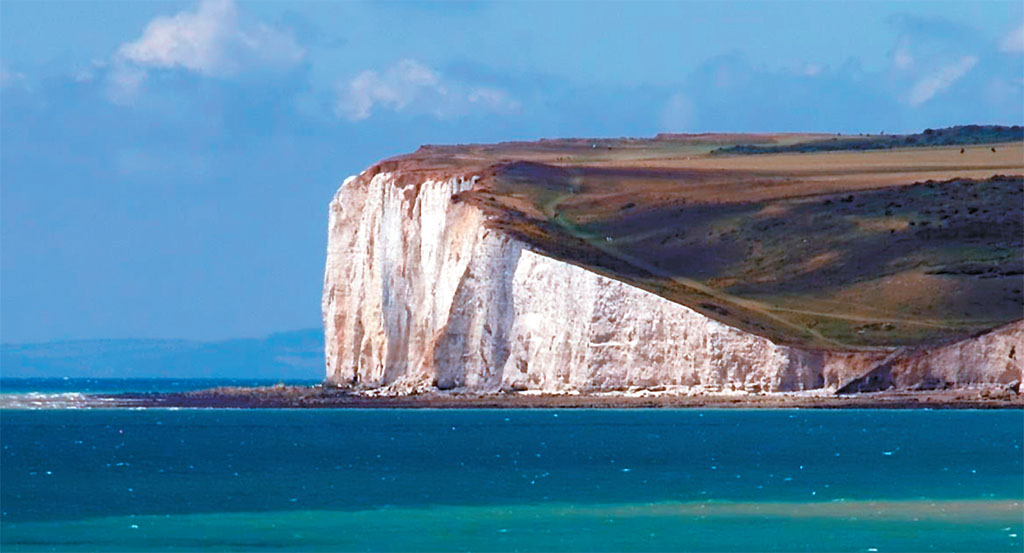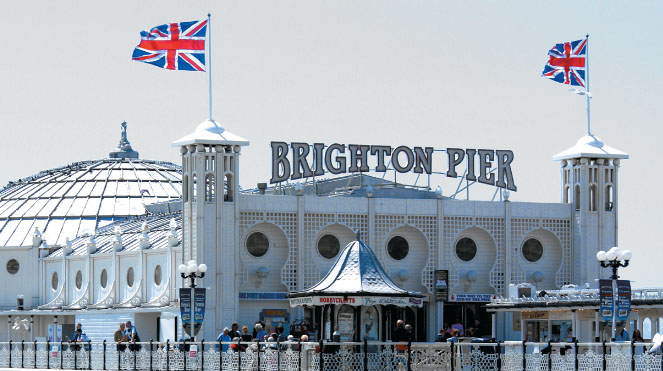
LITERATURE AND HISTORY, undulating green landscapes and seaside resorts, castles and cathedrals, cottage gardens and shingle beaches: it’s a microcosm of the English heritage. Here are gentle days of exploration in “The Garden of England.”
Day 1–On the Pilgrim Way
If you’re driving out of London, you’ll leave the city roughly along the same route that Chaucer’s Canterbury pilgrims followed in the late 1300s. An alternative is to take the train out of town to, say, Dept-ford, pick up a car there and join the pilgrims’ way to the southeast. Either way, an hour or so will have you in historic, Norman Rochester. Or, you can drive to Rochester in a couple of hours from either London airport. Charles Dickens is the favorite son; on Rochester’s pretty High Street, allusions to the novelist are everywhere. You might also climb to the top of Rochester Castle, England’s tallest Norman keep, and visit Rochester Cathedral. In nearby Chatham, the Historic Dockyard is a great visit; here they built ships of the line for Nelson and the Napoleonic Wars. Choose either the M2 motorway or the old A2 to follow the pilgrims to medieval Canterbury. Being accustomed to visitors, Canterbury has accommodations for every taste and budget.[caption id="Kentand1066Country_img1" align="aligncenter" width="661"]

DANA HUNTLEY
Day 2–The Tales of Canterbury
There’s a lot to see in Canterbury. And little wonder. It has been England’s ecclesiastical capital since St. Augustine arrived with the gospel in 597. Visit the ruins of his Benedictine monastery. Canterbury Cathedral, of course, is the mother church of the Anglican communion and seat of the Archbishop of Canterbury. You can’t miss the spot where Henry II’s knights murdered St. Thomas Becket at Christmas in 1170. Shades of Geoffrey Chaucer’s pilgrims and of Charles Dickens nudge into you everywhere in the narrow, cobbled precincts of ancient Canterbury. Do visit Grey Friars and the old Westgate. Its open tower roof provides the best views over the city and of the cathedral. You might return to the cathedral for choral evensong—an unforgettable experience.
Day 3–The White Cliffs of Dover
This morning, take an excursion to Deal and drive along the top of the famed white cliffs of Dover to the legendary port town of that name. Dover Castle, one of England’s most impressive coastal fortresses, is a must-see visit. Dover has guarded the channel coast from the days of the Romans to its secret tunnels used in World War II. Check out the bustling harbor, too. The tiny harbor is still the chief ferry port for commerce and people across the Straits of Dover to the Continent. You might time a return to Canterbury early enough so you can explore more of the city. It’s got the best shopping on your itinerary, and plenteous tempting options for food and drink.
Day 4—Through the Countryside to Sussex
You might route this morning to the harbor town of Folkestone, terminus of the Channel Tunnel, and along the A259 through Romney Marsh to lovely Rye. Pause for a ride on the very narrow gauge Romney, Hythe & Dymchurch Railway. Or take an inland route to Ashford and across the spectacular High Weald country to Tenterden. One option is Bodiam Castle, completed just as the 15th-century made these fortresses obsolete. Another compelling visit is Bateman’s, Rudyard Kipling’s home near Burwash. Either way, continue on to the charming, if faded, seaside town of Eastbourne. Apart from high summer, it’s easy to find a beachfront stay in any comfort range; anytime of year the terrific Tourist Information office will help.
Day 5—In 1066 Country
This morning’s excursion leads just a few miles to Battle, where Battle Abbey marks the site of the 1066 Battle of Hastings between William of Normandy and the Saxon King Harold. Explore the battle lines, and the ancient abbey the Conqueror built to celebrate his victory.
The village is full of ancillary visitor attractions. If yesterday didn’t offer opportunity to explore Eastbourne, this afternoon does. There’s a substantial shopping precinct stretching back from the beach; Eastbourne’s Edwardian pier is a classic, and there are theaters and entertainments galore along the trim waterfront. At the Winter Garden, watch the ballroom tea dancers most afternoons.
[caption id="Kentand1066Country_img2" align="aligncenter" width="1024"]

123RF/TIMO KOHLBACHER
Day 6–A Dawdle to Brighton, Lewis and Royal Tunbridge Wells
Follow the A259 coast road this morning along the chalk cliffs of Beachy Head. A short detour down the picture-postcard Cuckmere Valley yields the unspoiled village of Alfriston. You might visit the Alfriston Clergy House, the first property ever acquired by the National Trust (in 1896, for £10). Continue the short drive to the resort town of Brighton. Do pay a visit to King George IV’s oriental palace called the Royal Pavilion, then walk along Brighton’s famous pier and shingle beach or browse for antiques in The Lanes. Turning north, there might be time to explore the historic Sussex market town of Lewes, with the ruins of its castle and sites connected with Thomas Paine. Then, toddle on up to Royal Tunbridge Wells, which succeeded Bath as the spa of fashion near the turn of the 19th-century. Explore the shops, restaurants and pubs of the famous Pantiles, and sample the waters from the chalybeate springs.
[caption id="Kentand1066Country_img3" align="aligncenter" width="663"]

©LOOP IMAGES/MARK BOWERS
Day 7—A Day in the Country
There’s an embarrassment of riches in the Tunbridge Wells neighborhood. Leeds Castle, Penshurst Place, Hever Castle, Ightham Mote, Winston Churchill’s Chartwell, the gardens of Sissinghurst and the treasure-house of Knole are all gems within a few miles. Do resist the temptation to attempt too much. Pick any two and chart the day accordingly. Take a visit, for instance, to Chartwell in the late morning. Then scout for a pretty country pub and a leisurely ploughman’s lunch on your way to an afternoon visit to the moated Tudor manor of Hever Castle, home of the ill-fated Queen Ann Boleyn. You might return to Tunbridge Wells with time for last-minute shopping or another stroll along the Pantiles.
Day 8—Turning North Toward London
If you’re heading straight back to London, a 90-minute drive should do it (always allowing for heavy traffic into town). You can drop off the car at nearby Gatwick and take the train. With more time, you might visit one of the destinations that you didn’t get to yesterday, or detour slightly to Scotney Castle gardens. Once you hit the M25 orbital road around London, of course, it’s easy to continue your adventures clockwise into the West Country or counter-clockwise and across the Thames to East Anglia.





Comments